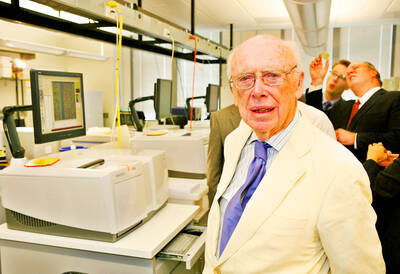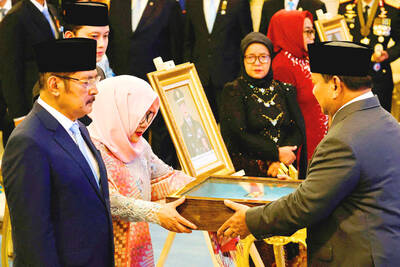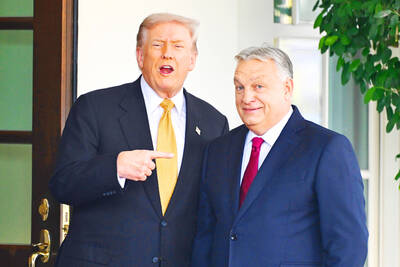Global warming is contributing to an unusually harsh typhoon season in China that started around a month early and has left thousands dead or missing, government officials and experts said.
"The natural disasters caused by typhoons in our country have been many this year," the head of the China Meteorological Administration, Qin Dahe, said in recent comments on his organization's Web site.
"Against the backdrop of global warming, more and more strong and unusual climatic and atmospheric events are taking place," he said.

PHOTO: AP
"The strength of typhoons are increasing, the destructiveness of typhoons that have made landfall is greater and the scope in which they are travelling is farther than normal," he said.
The vice minister of the Ministry of Water Resources, E. Jingping, also spoke last week about the unusual ferocity, frequency and earliness of typhoons in China this year.
He said the typhoon season in China normally starts around July 27, but this year the first typhoon hit the southern province of Guangdong on May 18.
"This is the earliest typhoon to hit Guangdong since 1949," he said in a speech.
Natural disasters in China this year have killed 1,699 people and left 415 missing, the nation's Red Cross Society said last week.
More than 1,300 of those died in weather-related incidents from May to the end of last month, the government reported earlier.
Those reports came before the arrival on last Thursday of Saomai, the eighth typhoon of the season and the strongest to hit China in 50 years.
Saomai killed at least 214 people, mostly in the two eastern coastal provinces of Zhejiang and Fujian, according to figures released yesterday.
The president of the Washington-based Earth Policy Institute, Lester Brown said that the weather in China over the past few months was reflective of the worldwide extent of the problem of global warming.
"The emerging consensus in the scientific community is that higher temperatures bring more frequent and more destructive storms," Brown said.
"Our seasons seem to be beginning earlier and ending later," he said.
According to NASA's Goddard Institute for Space Studies, the earth's average temperature has risen by 0.8?C since 1970, he said.
But this is only the beginning of what the UN's International Panel on Climate Change believes will be a rise in temperature for this century of 1.4?C to 5.8?C.
"Just imagine what typhoons and hurricanes might be like in the future," Brown said.
Simply put, the storms are caused when warmer oceanic and atmospheric currents interact with cooler currents in tropic and sub-tropical regions, experts say.
Many of the cooler oceanic currents stem from the melting of the polar ice caps that is occurring due to rising global temperatures, said Edwin Lau, who monitors global warming at Friends of the Earth in Hong Kong.
"The hurricanes and typhoons are due to hot air rising... and the hotter the air, the spinning of the hurricanes is faster, picking up more water," Lau said.
Meanwhile, as some areas of China are hit by more typhoons and the resulting floods, other areas are suffering from intense drought, which experts say is another by-product of global warming.
In a landmark report in the mid-1990s, the UN panel on climate change predicted that global warming would leave southern China drenched with more rains, while the north and west of the country would suffer worsening droughts.
In Sichuan Province, directly to the west of where much of the devastation from the typhoons has occurred, nearly seven million people are currently inurgent need of drinking water due to a severe drought, state press said on Friday.
In the southwestern city of Chongqing, the drought is beginning to threaten the water supply for about 17 million people, according to another state press report.

James Watson — the Nobel laureate co-credited with the pivotal discovery of DNA’s double-helix structure, but whose career was later tainted by his repeated racist remarks — has died, his former lab said on Friday. He was 97. The eminent biologist died on Thursday in hospice care on Long Island in New York, announced the Cold Spring Harbor Laboratory, where he was based for much of his career. Watson became among the 20th century’s most storied scientists for his 1953 breakthrough discovery of the double helix with researcher partner Francis Crick. Along with Crick and Maurice Wilkins, he shared the

OUTRAGE: The former strongman was accused of corruption and responsibility for the killings of hundreds of thousands of political opponents during his time in office Indonesia yesterday awarded the title of national hero to late president Suharto, provoking outrage from rights groups who said the move was an attempt to whitewash decades of human rights abuses and corruption that took place during his 32 years in power. Suharto was a US ally during the Cold War who presided over decades of authoritarian rule, during which up to 1 million political opponents were killed, until he was toppled by protests in 1998. He was one of 10 people recognized by Indonesian President Prabowo Subianto in a televised ceremony held at the presidential palace in Jakarta to mark National

US President Donald Trump handed Hungarian Prime Minister Viktor Orban a one-year exemption from sanctions for buying Russian oil and gas after the close right-wing allies held a chummy White House meeting on Friday. Trump slapped sanctions on Moscow’s two largest oil companies last month after losing patience with Russian President Vladimir Putin over his refusal to end the nearly four-year-old invasion of Ukraine. However, while Trump has pushed other European countries to stop buying oil that he says funds Moscow’s war machine, Orban used his first trip to the White House since Trump’s return to power to push for

LANDMARK: After first meeting Trump in Riyadh in May, al-Sharaa’s visit to the White House today would be the first by a Syrian leader since the country’s independence Syrian President Ahmed al-Sharaa arrived in the US on Saturday for a landmark official visit, his country’s state news agency SANA reported, a day after Washington removed him from a terrorism blacklist. Sharaa, whose rebel forces ousted long-time former Syrian president Bashar al-Assad late last year, is due to meet US President Donald Trump at the White House today. It is the first such visit by a Syrian president since the country’s independence in 1946, according to analysts. The interim leader met Trump for the first time in Riyadh during the US president’s regional tour in May. US envoy to Syria Tom Barrack earlier